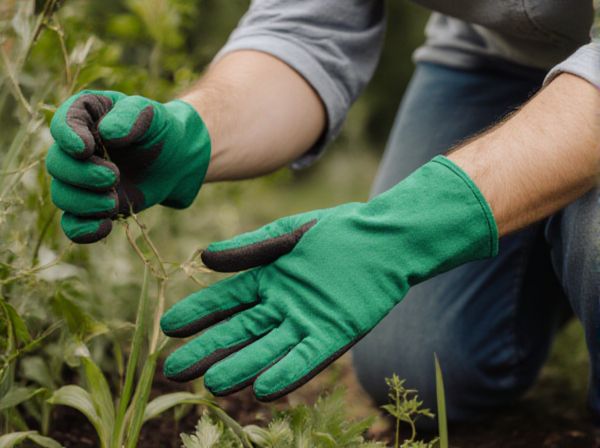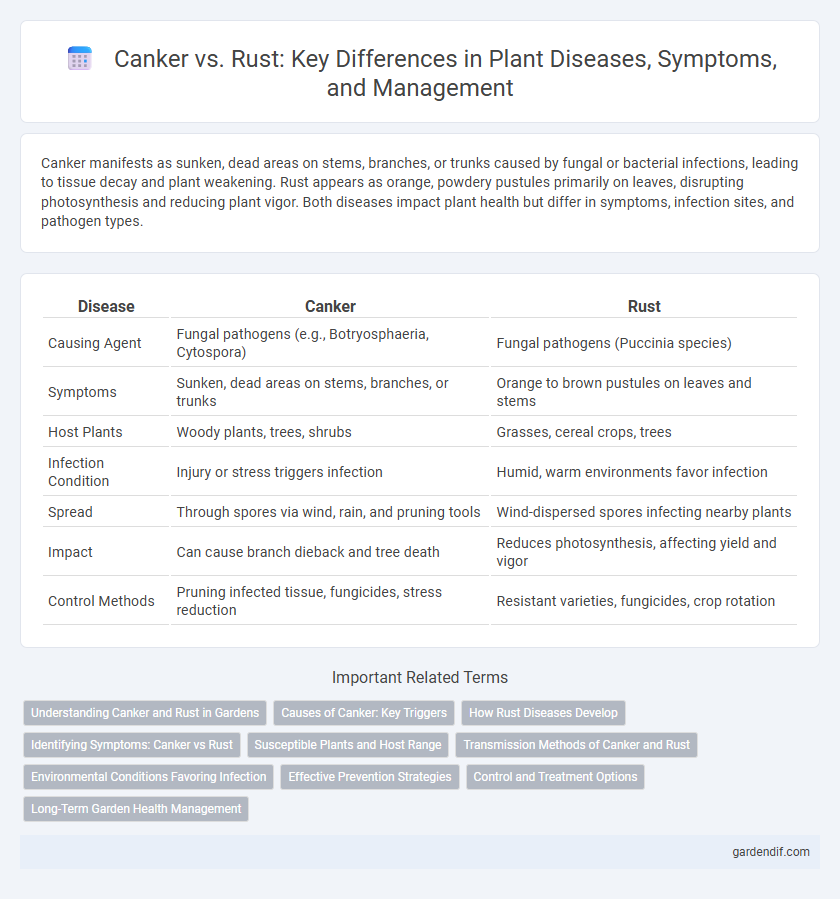
Canker vs Rust Illustration
Canker manifests as sunken, dead areas on stems, branches, or trunks caused by fungal or bacterial infections, leading to tissue decay and plant weakening. Rust appears as orange, powdery pustules primarily on leaves, disrupting photosynthesis and reducing plant vigor. Both diseases impact plant health but differ in symptoms, infection sites, and pathogen types.
Table of Comparison
| Disease | Canker | Rust |
|---|---|---|
| Causing Agent | Fungal pathogens (e.g., Botryosphaeria, Cytospora) | Fungal pathogens (Puccinia species) |
| Symptoms | Sunken, dead areas on stems, branches, or trunks | Orange to brown pustules on leaves and stems |
| Host Plants | Woody plants, trees, shrubs | Grasses, cereal crops, trees |
| Infection Condition | Injury or stress triggers infection | Humid, warm environments favor infection |
| Spread | Through spores via wind, rain, and pruning tools | Wind-dispersed spores infecting nearby plants |
| Impact | Can cause branch dieback and tree death | Reduces photosynthesis, affecting yield and vigor |
| Control Methods | Pruning infected tissue, fungicides, stress reduction | Resistant varieties, fungicides, crop rotation |
Understanding Canker and Rust in Gardens
Canker and rust are common plant diseases that affect garden health, with canker causing sunken, dead areas on stems and branches, often leading to plant death. Rust manifests as orange or rusty-colored pustules on leaves, weakening photosynthesis and reducing plant vigor. Early identification and treatment of canker and rust are essential to maintain garden productivity and prevent disease spread.
Causes of Canker: Key Triggers
Canker is primarily caused by fungal pathogens such as Botryosphaeria, Nectria, and Cytospora species, which invade plant tissues through wounds or natural openings. Environmental stressors like drought, frost damage, and poor soil drainage exacerbate vulnerability by weakening plant defenses. Unlike rust diseases caused by Puccinia fungi, canker results from localized necrosis disrupting vascular flow, leading to dieback and decay.
How Rust Diseases Develop
Rust diseases develop when fungal spores land on a susceptible host plant, germinating in warm, moist environments that facilitate infection. The fungi penetrate leaf tissues through stomata or direct epidermal invasion, forming pustules that release more spores to spread the disease. Environmental conditions such as high humidity and temperatures between 15-25degC accelerate rust spore germination, infection, and disease progression.
Identifying Symptoms: Canker vs Rust
Canker manifests as sunken, necrotic lesions on stems or branches, often accompanied by oozing sap and bark cracking, whereas Rust presents as powdery, rust-colored pustules predominantly on the undersides of leaves. The discoloration in Rust is typically orange to reddish-brown, contrasting with the dark, dry lesions characteristic of Canker. Early identification hinges on observing these distinct lesion types and host tissue responses to effectively differentiate and manage each disease.
Susceptible Plants and Host Range
Canker primarily affects woody plants such as apple, cherry, and oak trees, showing a narrow host range concentrated on specific tree species susceptible to fungal pathogens like Nectria and Cytospora. Rust diseases have a broader host range, targeting various herbaceous and woody plants, including cereals like wheat and barley, as well as ornamental plants, with pathogens from the Puccinia genus exhibiting complex life cycles involving alternate hosts. Understanding the susceptible plants and host range is crucial for effective disease management and prevention strategies in agriculture and forestry.
Transmission Methods of Canker and Rust
Canker diseases primarily spread through the infection of wounds caused by pruning, mechanical damage, or insect activity, allowing fungal or bacterial pathogens to enter host plants. Rust diseases transmit via airborne spores that can travel long distances, infecting susceptible plants through stomata or direct penetration. Both diseases rely on environmental conditions like humidity and temperature to facilitate effective transmission and infection cycles.
Environmental Conditions Favoring Infection
Canker diseases thrive in warm, moist environments where wounds or natural openings on plants allow pathogens to enter, often exacerbated by prolonged rainfall or high humidity. Rust infections favor cool, wet conditions with dew or fog that facilitate spore germination on leaf surfaces, typically occurring in temperate regions during spring and fall. Both diseases require specific environmental factors such as temperature ranges and moisture levels to initiate infection and spread effectively.
Effective Prevention Strategies
Effective prevention strategies for canker emphasize proper pruning techniques to remove infected branches and promote airflow, reducing fungal spore accumulation. Rust prevention relies on planting resistant crop varieties and applying timely fungicide treatments to interrupt the disease cycle. Both diseases benefit from crop rotation and maintaining field sanitation to minimize pathogen reservoirs.
Control and Treatment Options
Control of canker involves pruning affected branches and applying fungicides containing copper or chlorothalonil to prevent spore spread, while ensuring proper tree nutrition to enhance resistance. Rust control requires removing alternate host plants, applying sulfur-based fungicides during early infection stages, and maintaining adequate spacing for air circulation to reduce humidity. Integrated management practices combining cultural, chemical, and resistant varieties provide effective treatment for both diseases.
Long-Term Garden Health Management
Canker causes sunken, dead areas on stems and branches, weakening plant structure over time, while rust forms pustules that disrupt photosynthesis and reduce vigor. Implementing crop rotation, resistant cultivars, and regular pruning improves long-term garden health by minimizing disease reservoirs and enhancing air circulation. Applying targeted fungicides during early infection stages further supports sustainable disease control for both canker and rust.
Canker vs Rust Infographic

 gardendif.com
gardendif.com